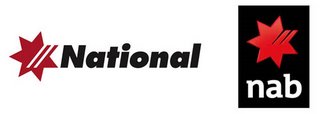
Last month Australia's largest lender, the National Australia Bank (NAB), unveiled its revamped corporate logo and a new take on what is a decidedly uninteresting but functional name, 'nab'. Like most rebrands, NAB’s is no different - a redesign can cost millions, most of which is spent on standard roll out of a new mark. Buildings, websites and a whole lot of collateral, are reshaped and shredded to suit the new look (don’t get us started on the fact that even their new brochures still apply the superior case!). Cheques, letterheads, pens and business cards are binned and replaced. However, what is disappointing about this latest corporate makeover is how much it seems more of an attempt at papering-over the cracks in the organisation, than a radical re-envisioning.
One of the reasons cited for the rebrand was the NAB’s 2004 foreign exchange desk scandal, which saw it lose $360 million and consequently it’s CEO and much of its senior management team.
Interestingly some sections of the market have taken a completely different view of the makeover. Analysts seem to have a view that these kinds of spackfilla jobs “win no leverage”.
"The brand name and image is something that is more important to its customers - particularly retail customers. It's not a fact that is likely to drive a price-earnings model", said a Citigroup analyst quoted in the Sydney Morning Herald.
DIFFUSION finds comments like this somewhat disingenuous. Most company valuations always take an account of brand equity and in the case of NAB, there was a significant loss of equity when the FOREX scandal hit.
Traditionally brand valuation consists of four main strands covering fundamental financial and balance sheet analysis, contextual market and consumer analysis, brand analysis examining brand as a determining factor in the future earnings and the value accorded the brand and mark as intellectual property. A number of factors can be added under these headings and weighted according to their importance or relevancy. Consumer analysis, for example, should include customer satisfaction, brand preference, quality perceptions, value for money and good service while market analysis should include share of market, share of voice and growth statistics. Any financial analysis would include profitability, sales and margins forecasts. All of these can be combined to give total brand value and as such a price-earnings model does take account of the impact of customer sentiment on overall earnings.
Secondly, while NAB CEO Ahmed Fahour acknowledged during the week of the relaunch, "I've got the number one business bank in this country I've got the wealth management business. I've got a smaller but turning-around retail business. And the fact is that I can have one consistent conversation with you and we are all singing from one hymn sheet," there is also the need for organisations such as NAB to use their brand to be one of the determinants of their dialogue and interaction with customers. It’s not good enough to just trot out what is rather poorly realised signifier alongside the diminutive name; in NAB’s cade, the follow up to their rebrand, the new brand promise needs to be sold through the organisation.
When DIFFUSION talked to one of the nice NAB counter staff after the re-brand, they acknowledged that they had no real involvement in the process and didn’t know what what the new brand promise “We believe in people with ideas and dreams. Helping you fulfil yours is at the heart of everything we do” really meant.
So will customers see a different organisation and feel any different? Can a bank, or for that matter any institution or organisation, really help you to realise your “dreams”?
No comments:
Post a Comment